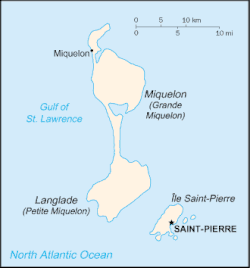Langlade Island
| Miquelon-Langlade | |
|---|---|

Aerial view of Miquelon town
|
|
 |
|
| Coordinates: 47°06′00″N 56°22′45″W / 47.100000°N 56.3792°WCoordinates: 47°06′00″N 56°22′45″W / 47.100000°N 56.3792°W | |
| Country | France |
| Overseas collectivity | Saint Pierre and Miquelon |
| Government | |
| • Mayor (2014-2020) | Jean de Lizarraga |
| Area | 205 km2 (79 sq mi) |
| Population (2011)1 | 624 |
| • Density | 3.0/km2 (7.9/sq mi) |
| Time zone | PMST (UTC-3) |
| • Summer (DST) | {{{timezone_DST{{{time zone DST}}}}}} ([[UTC{{{utc_offset_DST{{{utc offset DST}}}}}}]]) |
| INSEE/Postal code | 97501 / 97500 |
| Elevation | 0–240 m (0–787 ft) |
| 1Population without double counting: residents of multiple communes (e.g., students and military personnel) only counted once. | |
Miquelon-Langlade is the larger and less populated of the two communes (municipalities) making up the French overseas collectivity of Saint Pierre and Miquelon, located to the south of Newfoundland in the Gulf of St. Lawrence. It consists of three geological islands: Miquelon, Langlade and Le Cap, connected with tombolos (sand dunes). The communal seat is the settlement of Miquelon, on the northern tip, where the entire island's permanent population of 623 is located. Miquelon Airport provides flights to Montreal and to nearby Saint-Pierre.
Located in the Gulf of St. Lawrence, west of Newfoundland's Burin Peninsula, Miquelon-Langlade covers a total land area of 205 square kilometres (79 sq mi). It is made up of three geologically distinct islands bound together by tombolos—long strips of sand dune— Le Cap in the north, Miquelon (Grand Miquelon) in the center and Langlade (Petite Miquelon) in the south.
On the south of the Miquelon Island is a large lagoon known as the Grand Barachois which is host to a large population of seals and other wildlife. Miquelon is also a well known destination for bird watching.
An 8-mile (13 km) long tombolo sandspit called La Dune connects Miquelon and Langlade. In the 18th century it was still possible to sail a boat between Miquelon and Langlade, but by the end of that century La Dune had closed in to form an isthmus between the islands.
Located at 3 mi (4.8 km) west of Saint Pierre Island, Langlade is an ancient peneplain drained by numerous short rivers, including the Belle, the largest, which flows to the northwest. The coast of Langlade is lined with steep cliffs, except to the northwest.
...
Wikipedia
